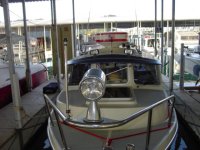This is an interesting topic, and a good discussion. As always, the adaptations we do to our boats depends upon their use. Certainly, those who are routinely on the water at night (for fishing, or driving a tow boat at 10 knots along a narrow winding canal) have a different use and a different need than those of us who are only out at night when they have misjudged time or had an unplanned event delay them.
Comparing a boat to a car is, for our use of the boat, similar to comparing a boat to a 747 -- two totally different animals with totally different uses. A car is routinely used at night -- we rarely use our boat after dark -- two or three times -- in 6 years. Our car we often drive at night at 75 mph; our boat, the few times we have been forced to travel at night, we rarely exceed 2 knots. Our boat is equipped with night eyes (the radar) and our car is not.
Radar (observed with good night vision) 'sees' all the major landmarks (like the shore, a rock, a bridge abutment, or marker), better than a 55 amp light when off a 1/2 mile, and can be used for navigating into harbor or cove a few miles off far better than the light). Our handheld spot turned on every minute or so 'sees' smaller objects (logs, etc) in the water when traveling slowly.
With a car, you are driving a narrow strip -- with a boat rarely -- Do airplanes fly with spotlights? No, they have space around them and use lights only when landing or taking off. We usually have space around us and, of course, use the handheld spot for 'landing.'
Since our boat use is in daylight, a spotlight is only for the rare time when out at night -- and we don't want a large object mounted ahead of our vision for the 99.9% of the time we do use our boat.
So, we think having mounted spotlights are a great idea for those who do a lot of night travel -- but not necessary for those who do not.


